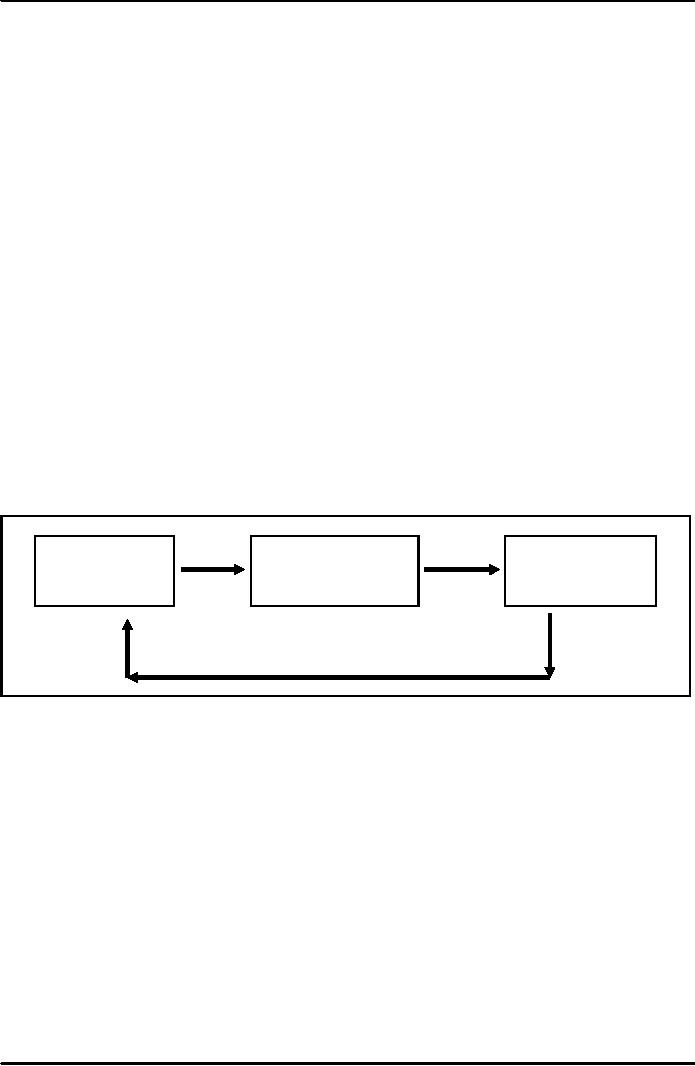 |

Introduction
To Public
AdministrationMGT111
VU
LESSON
24
PERFORMANCE
APPRAISAL
At the
end of lecture the students
will be able to:
-
Explain
the concept of Performance
Appraisal
-
Examine
Types of Performance Appraisal
-
Examine the
need for performance
Appraisal
-
Understand
the concept of Compensation
-
Understand
the need for promotion,
demotion and transfer and
the 4 C's model
What
is Performance Appraisal
Performance
Appraisal means to evaluate, judge or
check the work of employee
over a period of
time,
and then inform whether the
employee achieved the objectives in
that time period.
Following
are the characteristics of the
Performance Appraisal:
1.
Agreed Objectives related to the assigned
job/standard (job and
position description)
2.
Time period
3.
Skills required to achieve
objectives
4.
Check that objectives
are achieved or not
5.
Inform the employee if the
objectives were achieved or
not
6.
If not achieved why
these were not
achieved
7.
If achieved, reward and
motivate
In
the above characteristics, 6 and 7
constitute "feedback"
Figure
1
Agreed
Objectives
Objectives
Work
Performed
/
Performance
achieved/
Standard
Standard
Achieved
Feedback
(Accountability)
In
figure 1 the whole process of performance
evaluation is shown in diagrammatic form,
indicating
that
performance evaluation starts with
agreed objectives or performance
standards, then the work
is
performed
and then it is checked if
objectives are
achieved.
Importance
of Performance appraisal
Performance
appraisal is important task of
managers to help other
employees to improve
their
performance.
The manager who supervises
the work of subordinate, knows the knowledge,
skills and
attitudes
required for accomplishing jobs
and whether these are
possessed by employees.
Performance
Appraisal of employees is important for
the organization because the appraisal
of
work
completed by each employee
determines whether the organization is moving in the
direction of its
objectives.
However, most managers find
it difficult to help others to
coach ( guide) and
appraise
performance
of employee. Judging an employee's
performance accurately is not
always easy, because
it
requires
constant watch on the work of
employees.
87

Introduction
To Public
AdministrationMGT111
VU
Types
of Appraisal
There
are mainly two types of
appraisal in the organization. Which
are:
-
Formal
Appraisal
-
Informal
Appraisal
Formal
Appraisals
Formal
systematic appraisal usually
occurs semi-annually or annually. Formal
appraisal has four
major
purposes:
1.
To
let employees know formally
how their current performance is being
rated;
2.
To
identify employees who
deserve merit raises;
3.
To
locate employees who need
additional training;
and
4.
To
identify candidates for
promotion
How
is Formal Appraisal
Done?
As
we know Human Resource
manager have job and
position descriptions for
all jobs in the
organization.
The objectives to be achieved
are mutually agreed between
the `supervised' and
`supervisor'.
The
agreed objectives are
written down on a `form'.
This form is a special form
which contains
following
information:
1.
Name
of employee
2.
Job
title
3.
Job/position
description
4.
Objectives/goals
to be achieved in a year or six months or
three months
5.
training
received
6.
Training
to be received
7.
Does
the employee require special
guidance
8.
Strengths
and weakness of
employee
9.
Signature
of immediate boss
The
performance appraisal forms are
different in different organizations
but most of the form
will
have
the above information.
Informal
Appraisals
Informal
appraisal is a day to day
routine appraisal, when managers
meet their subordinate
almost
daily.
In this process they use following
methods:
1.
Observe
2.
Communicate
3.
Check
work
4.
Give
immediate feedback
So
informal performance appraisal
means continual process of
feed back to employees. It
is
information
about how well employees are
doing their work for the
organization. Informal appraisal can
be
conducted
on a day-to-day basis.
Compensation
Compensation
is the monetary return given to employee
for the work they do in a position/job
in
an
organization. There are three types of
compensation:
1.
Standard
salary/ wage that one
receives for being in that particular
position
2.
Additional
compensation for doing work
not defined in the job and
position description
3.
Fringe
benefits/perquisites (like provision of transport,
utility bills etc.)
Compensation
has traditionally been
linked to a particular job or job
description. The general
idea
is
that more the responsibility a manager
has, the more compensation he or
she should earn. Often
times
salary
for jobs are rated by a
job evaluation system which
takes into account such
variables as:
88

Introduction
To Public
AdministrationMGT111
VU
1.
The
number of subordinates supervised by
manager/supervisor,
2.
Level
in the organizational hierarchy, and
3.
Complexity
(level of difficulty) and importance of
job functions.
In
a bureaucratic structure, senior
organizational executives are paid very well, as
compared to low
level
employees. They are also paid
perquisites and other
benefits.
Some
organization pay wages and
salaries in accordance with the
difficulty and risk of life
involved
in
the jobs, e.g. Commercial
Pilot are paid more.
Promotions,
Transfers, Demotions, and Separations
(Lay Off)
Employees
are promoted to next higher
position when their performance is in
accordance with
standards
laid down by the organizations,
i.e. when employees achieve
targets over a given period of
time,
for
certain number of years.
Employees
are transferred for variety of
reasons. When employee is
promoted, they can be
transferred
because the higher level position may be
available at some other
places. Employees are
transferred
because the performance may
not be satisfactory and organization
cannot lay-off employee,.
Employees
may be transferred for
personal reasons or they are
transferred because of on the-job
training.
Demotion
is a kind of punishment. When employees
have not performed according
to the laid
down
standards, or show indiscipline or
disobedience or negligence or
irresponsibility etc. they may
be
demoted
In
case of extreme and continuous
negligence and indiscipline
employees can be laid-off.
The
movement
of personnel within an organization
their promotion, transfer, demotion,
and separation is a
major
aspect of human resource
management. The actual
decisions about whom to promote
and whom to
fire
can be the most difficult,
and important, which a
manager has to make.
The
Four C's Model
The
Four Cs model forms the basis of HRM. It
addresses areas that must be
focused when
selecting
people for organization. These
are:
1.
Competence.
How
competent are employees in their work? Do
they need additional training?
Performance
evaluations by managers can
help determine what talent is available.
To what
extent
do HRM policies attract, keep
and develop employees with
skills and knowledge
needed
now
and in the future?
2.
Commitment.
How
committed are employees to their
work and organization?
Surveys can be
conducted
through interviews and questionnaires to
find answers to this
question.
3.
Congruence.
Is
there agreement, between the
basic philosophy and goals
of the organization
and
its employees? Is there trust
and common purpose
between
manages
and
employees?
Incongruence can be detected in the
frequency of strikes,
conflicts
between
managers
and subordinates, and
grievances. A low
level
of congruence results in low
levels
of
trust.
4.
Cost
effectiveness. Are
HRM policies cost-effective in terms of
wages? benefits,
turnovers,
absenteeism,
strikes, and similar
factors
Conclusions
The
process of performance appraisal
both formal and informal
was discussed. The
formal
method
of performance appraisal helps
organization to determine if the employees
are working to
achieve
the
goals of organization. And if they are
unable to do so then what are the
gaps in skills or knowledge
for
which
training should be imparted training.
Performance also helps in determining the
compensation and if
promotion,
demotion or lay-off is to be done.
All the processes of HRM are
interconnected and
interrelated.
89

Introduction
To Public
AdministrationMGT111
VU
Concepts
Performance
appraisal:
evaluation
or checking the work employees
over a period of time.
Compensation:
wages
and salaries given to employees in a
job position.
Competence:
ability
to perform on a particular job.
90
Table of Contents:
- INTRODUCTION:Institutions of State, Individualism
- EVOLUTION OF PUBLIC ADMINISTRATION:Classical School, The Shovelling Experiment
- CLASSICAL SCHOOL OF THOUGHTS – I:Theory of Bureaucracy, Human Relation Approach
- CLASSICAL SCHOOL OF THOUGHTS – II:Contributors of This Approach
- HUMAN RELATIONS SCHOOLS:Behavioural School, System Schools
- POWER AND POLITICS:Conflict- as Positive and Negative, Reactions of Managers, Three Dimensional Typology
- HISTORY OF PUBLIC ADMINISTRATION – I:Moghul Period, British Period
- HISTORY OF PUBLIC ADMINISTRATION – II
- CIVIL SERVICE:What are the Functions Performed by the Government?
- CIVIL SERVICE REFORMS:Implementation of the Reforms, Categories of the Civil Service
- 1973 CONSTITUTION OF PAKISTAN:The Republic of Pakistan, Definition of the State
- STRUCTURE OF GOVERNMENT:Rules of Business, Conclusion
- PUBLIC AND PRIVATE ADMINISTRATION:The Public Interest, Ambiguity, Less Efficient
- ORGANIZATION:Formal Organizations, Departmentalization
- DEPARTMENTALIZATION:Departmentalization by Enterprise Function, Departments by Product
- POWER AND AUTHORITY:Nature of Relationship, Delegation of Functional Authority
- DELEGATION OF AUTHORITY:The Art of Delegation, Coordination
- PLANNING – I:Four Major Aspects of Planning, Types of Plans
- PLANNING – II:Planning ProcessThree principles of plans
- PLANNING COMMISSION AND PLANNING DEVELOPMENT:Functions, Approval Authority
- DECISION MAKING:Theories on Decision Making, Steps in Rational Decision Making
- HUMAN RESOURCE MANAGEMENT (HRM):Importance of Human Resource, Recruitment
- SELECTION PROCESS AND TRAINING:Levels at Which Selection takes Place, Training and Development
- PERFORMANCE APPRAISAL:Formal Appraisals, Informal Appraisals
- SELECTION AND TRAINING AND PUBLIC ORGANIZATIONS:Performance Evaluation,
- PUBLIC FINANCE:Background, Components of Public Finance, Dissimilarities
- BUDGET:Components of Public Income, Use of Taxes, Types of Taxation
- PUBLIC BUDGET:Incremental Budget, Annual Budget Statement, Budget Preparation
- NATIONAL FINANCE COMMISSION:Fiscal Federalism Defined, Multiple Criteria
- ADMINISTRATIVE CONTROL:Types of Accountability, Internal Control, External Control
- AUDIT:Economy, Effectiveness, Objectives of Performance Audit, Concepts
- MOTIVATION:Assumptions about Motivation, Early ViewsThree Needs
- MOTIVATION AND LEADERSHIP:Reinforcement Theory, Leadership, The Trait Approach
- LEADERSHIP:Contingency Approaches, Personal Characteristics of Employees
- TEAM – I:Formal & Informal teams, Functions of Informal Groups, Characteristics of Teams
- TEAM – II:Team Cohesiveness, Four ways to Cohesiveness, Communication
- COMMUNICATION – I:Types of Communication, How to Improve Communication
- COMMUNICATION – II:Factors in Organizational Communication, Negotiating To Manage Conflicts
- DISTRICT ADMINISTRATION:The British Period, After Independence, The Issues
- DEVOLUTION PLAN – I:Country Information, Tiers or Level of Government
- DEVOLUTION PLAN – II:Aim of Devolution Plan, Administrative Reforms, Separation of powers
- POLITICAL REFORMS:District, Tehsil, Functions of Union Council, Fiscal Reforms
- NEW PUBLIC MANAGEMENT (NPM):Strategy, Beginning of Management Approach
- MANAGERIAL PROGRAMME AGENDA – I
- MANAGERIAL PROGRAMME AGENDA – II:Theoretical Bases of Management, Critique on Management